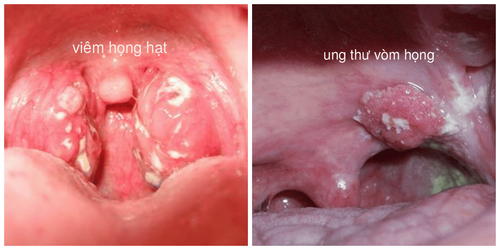This is an automatically translated article.
Nasopharyngeal cancer is one of the 10 common cancers in Vietnam and is difficult to detect because the tumor is located deep inside the nasal cavity and throat along with atypical symptoms similar to common ENT disease. . Therefore, the diagnosis of nasopharyngeal cancer needs to be diagnosed with imaging techniques to give accurate results.1. Nasopharyngeal cancer
Nasopharyngeal cancer, also known as nasopharyngeal carcinoma, is cancer that arises from the cells of the oropharynx, especially the pharynx, just behind the nose. Nasopharyngeal cancer is one of the 10 most common cancers in Vietnam, accounting for 10-12% of all cancers of the head, face and neck. If the disease is not detected at an early stage and treated promptly, the mortality rate is very high.There are many causes of oropharyngeal cancer including:
Frequent exposure to dust, chemicals, rubber, synthetic resins, radiation; Eat a lot of fermented foods, sour foods such as salted fish, pickles, pickled tomatoes, smoked meat,... Using stimulants such as alcohol, smoking, using stimulants,... History Having a family member with oropharyngeal cancer. Early signs and symptoms of nasopharyngeal cancer include:
Persistent sore throat; Swollen neck lymph nodes: The most common is the angled lymph nodes of the jaw, the prominent feature is the small, firm, painless lymph nodes that are often discovered by accident; Nasal congestion: This sign will appear gradually, at first the patient will have a stuffy nose, stuffy one at a time. Some other accompanying symptoms such as bloody nasal mucus or nosebleeds; Headache: Often dull headache, migraine, sometimes the pain is sharp, easily confused with neurological and cerebrovascular diseases; Tinnitus, hearing loss, hearing loss on one side due to tumor blocking the Eustachian tube; drooping eyelids, double vision, decreased or lost vision; Difficulty swallowing, coughing up blood mixed in saliva.

Ung thư vòm họng là một trong 10 loại ung thư phổ biến nhất tại Việt Nam
2. Diagnosis of nasopharyngeal cancer
Early signs of nasopharyngeal cancer are often confused with common ENT diseases. Therefore, in addition to the clinical symptoms, the doctor should appoint to perform subclinical diagnostic measures to help determine accurately. Currently, developed medicine has advanced, modern, non-invasive imaging techniques that are easy to perform quickly and bring accurate results. Some imaging methods used in diagnosing nasopharyngeal cancer include:
2.1 Otolaryngoscopy Endoscopy otolaryngology using specialized endoscopic instruments for detailed observation pharynx, to detect abnormalities, vascular proliferation in the nasopharynx. Tumors that grow large often cause damage to healthy cells and cause swelling. Otolaryngoscopy can help detect the location and size of a tumor.
Advantages: The flexible endoscope can be easily aligned, angled to help observe many angles in the nasopharynx; Less pain and irritation of the throat mucosa for the patient Quick implementation time only takes about 5-10 minutes; Disadvantage: This technique requires the doctor to have expertise and experience in adjusting the endoscope. 2.2 X-ray X-ray X-ray is a diagnostic imaging technique that helps to determine details related to a tumor such as its shape, size, and degree of impact on soft tissues. Cranial x-rays in the diagnostic evaluation of nasopharyngeal cancer can be performed in a variety of positions. In which, the Hirtz position helps the doctor to observe the images of the lower jaw bone, lower jaw angle, cheekbone arch, outer ear canal, oval foramen, spinous foramen, sphenoid and maxillary sinuses,...
Advantages: Fast execution time, short waiting time for results. The technique is non-invasive, causing no pain or discomfort to the patient. Disadvantages: X-rays that use X-rays or Rontgen rays have high energy radiation and can be dangerous to human health. Therefore, care should be taken when performing this technique for people with pacemakers, pregnant women, and young children.

Siêu âm vùng cổ nhằm phát hiện hạch nổi bất thường hay di căn
2.3 CT Scanner or MRI MRI CT Scanner or MRI are both modern and advanced imaging methods that help doctors observe the nasopharyngeal area through radiographs. and provide high accuracy. This method is done to determine the location, shape, size of the tumor and the extent of metastasis of the cancer cells. However, these methods are often combined diagnostic with biopsy or biochemical tests to give accurate results.
Advantages: These are all non-invasive laboratory tests, causing no pain or discomfort for the patient. Quick execution time, short response time. Cons: CT Scanner uses X-ray radiation and can be harmful to the body, especially when X-rays have the characteristic of accumulation. Therefore, when performing this technique, attention should be paid to people with pacemakers, pregnant women, and young children,... 2.4 Ultrasound
Ultrasound of the neck to detect abnormally raised lymph nodes or metastasis. This technique is performed by inserting a transducer that emits sound waves into the patient's throat area. It will then be converted to an image and can see abnormalities in the nasopharynx.
Advantages: Ultrasound does not irritate the nasopharynx and cause harm to the body. Quick execution time and immediate results. Cons: Some locations in the nasopharynx have many nooks and crannies, making it difficult to diagnose. Doctors need to combine with other testing methods to make an accurate diagnosis. In summary, nasopharyngeal cancer is one of the most common cancers, and is often confused with other common ENT diseases. Currently, medicine has developed and there are many methods of diagnosing oropharyngeal cancer by non-invasive images, giving quick and accurate results such as endoscopy, ultrasound, x-ray, CT Scanner, scan. MRI,... Nasopharyngeal cancer if not detected and treated early, the risk of death is high. Therefore, when seeing abnormal symptoms, it is necessary to immediately go to a medical facility for examination, diagnosis and timely intervention.
Early cancer screening is considered a perfect measure in the timely detection and treatment of all types of cancer. Reduce treatment costs and especially reduce patient mortality. Vinmec International General Hospital always deploys and introduces to customers Early cancer screening at Vinmec - Peace of mind to live well to help with gene testing, imaging, and biomarkers for tumor detection. Soon. Vinmec International General Hospital has many packages of early cancer screening.
Only one gene test can assess the risk of 16 common cancers in both men and women (lung cancer, colorectal cancer, breast cancer, pancreatic cancer, neck cancer) uterus, stomach cancer, prostate cancer,....) Early detection of early signs of cancer through imaging, endoscopy and ultrasound. The examination operation is simple, careful and accurate. A team of well-trained specialists, especially in oncology, is capable of handling cancer cases. With equipped facilities, advanced and modern medical equipment and a team of doctors with deep expertise and experience. At Vinmec, the examination process becomes quick with accurate results, saving costs and time for patients.
Please dial HOTLINE for more information or register for an appointment HERE. Download MyVinmec app to make appointments faster and to manage your bookings easily.













